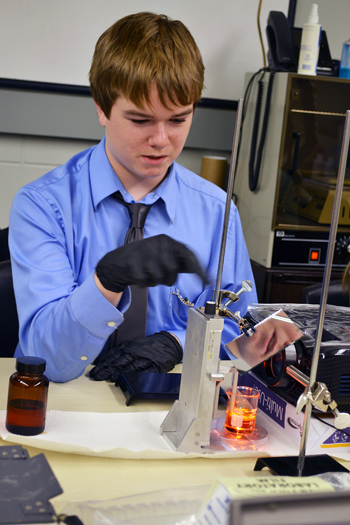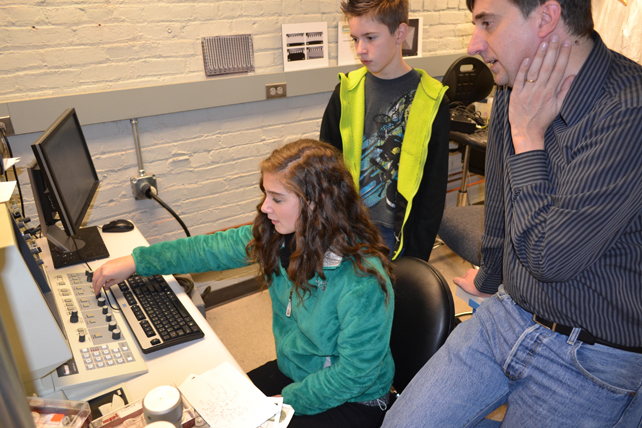Danville Teacher Partners with Illinois To Expose Students to STEM

Danville Lutheran science teacher, Kim Wright (center), watches as two of her students perform a 3D printing activity in Illinois' Mechanical Engineering Lab.
December 12, 2013
At the conclusion of a Nanotechnology Teacher Institute in the summer of 2010, Joe Muskin, then Education Outreach Coordinator for the Nano-CEMMS Center, encouraged participants to consider the Center—including its facilities, nanoscience supplies for classroom activities, and expertise—to be a resource for them. Kim Wright, a science teacher at Danville Lutheran School, took him at his word. So on December 12, 2013, to reward six 5–8th grade students for doing well on their compound microscope unit, Wright brought them to the Illinois campus to experience a Scanning Electron Microscope (SEM) and to learn how to use 3D printers.
In addition to teaching science, Wright also teaches art and literature, and believes the STEM emphasis during the field trip helps to foster interdisciplinary learning.
"The activities the students do during the trip and the follow-up projects merge science, technology, and art," says Wright.
Cognizant of the growing importance of technology in our society, Wright believes the experience had a number of benefits for her students:
"The afternoon was a wonderful mixture of awe, focused skill-building, and fun. They learned that they could handle the 'intimidating' equipment and processes with guidance and practice. Technology is a growing part of our daily world, and this type of activity links science and technology concepts very well."

Danville Lutheran middle school student makes an adjustment while printing a 3D image.
Although only a few students got to make the trip, she hopes her entire class will reap the benefits: "Every other year, I bring a small group to the campus to work at the Nano-CEMMS Center. These students are trained to use the SEM and to do 3D printing; however, the work that this group does with Mr. Muskin benefits the whole class. The SEM images will be incorporated into a large-scale art project for all my 7th and 8th graders."
Wright also sees the field trip as an opportunity to train her students, who will mentor their fellow classmates: "These 6 students will make excellent lab partners in the spring when the 3D printers are set up at our school."
In addition, Wright sees the partnership with the university as an opportunity to give her students a taste of what college is like: "As a teacher in a small school, I saw a chance to give a great hands-on experience to the students and to open their eyes a bit to the college-level academic environment offered at the University."
Wright's connection to the University goes beyond attending the teacher institute. Not only did her husband graduate from Illinois, but her son currently attends, and her daughter has been accepted for the Fall 2014 term.
Did her students enjoy the trip? "One student summed the afternoon up very well, 'Best day ever!'" says Wright. "During the drive home," Wright continues, " I asked the students how they would rate the trip on a scale of 1 to 10. A resounding "12" came from the passenger seats."
"Thank you," adds Wright. "The students loved the experience and felt like 'real' scientists."
Story and photographs by Elizabeth Innes, Communications Specialist, I-STEM Education Initiative.
More: K-6 Outreach, 6-8 Outreach, Nano-CEMMS, 2013
Note: Funding for the Center for Nanoscale Chemical-Electrical-Mechanical Manufacturing Systems has expired; however, as the Education Coordinator for the Mechanical Science and Engineering Department, Joe Muskin continues to provide education outreach to the community.

Joe Muskin (right) explains to two Danville Luteran students how the SEM works.













.jpg)
















